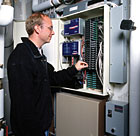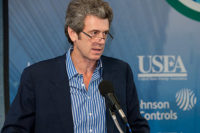
The energy management system at the BigHorn Home Improvement Center, a retail complex in Silverthorne, Colo., optimizes the operation of the mechanical and lighting systems, and illustrates one of the hot topics at the World Engineering Congress - reducing energy demand. (Photo by Jim Yost - Courtesy of the National Renewable Energy Laboratory.)
ATLANTA - The need to conserve energy personally was brought home when the World Energy Engineering Congress (WEEC) opened on a hot and steamy summer day in Atlanta that topped 100°F. The need to reduce energy demand and conserve energy collectively was then discussed by the speakers at the 30th annual conference.
Paolo Bertoldi, Ph.D., program manager, European Commission DG JRC, Institute for Environment and Sustainability, began the opening session by presenting the European viewpoint, discussing new developments in European energy efficiency policies.
Bertoldi said that recent climate change, security of the energy supply, and a tripling of oil prices have brought the energy issue to the forefront. European Union (EU) energy trends include high dependency on the importation of oil and high energy intensity. “Energy demand continues to rise 1 to 2 percent per year,” he said.
In 10 years, the EU could be consuming 10 percent more energy of which around two-thirds could be imported. “A key topic is how to improve efficiency,” he noted.

Climate change, security of the energy supply, and a tripling of oil prices have brought energy to the forefront, said Paolo Bertoldi, Ph.D., program manager, European Commission DG JRC, Institute for Environment and Sustainability.
The European action plan includes minimum performance requirements for appliances and equipment as well as building performance requirements. For buildings, the EU is looking at an integrated approach to saving energy, encompassing HVAC, insulation, controls, etc. Bertoldi said the EU wants to apply minimum standards to all buildings, new and existing, and it is developing certification schemes for all buildings.
For the industrial sector, emphasis is being put on energy management and Bertoldi said the EU will soon have an energy management standard.
“Energy efficiency is key for the security of the energy supply,” stated Bertoldi. Thus, he said, EU directives are imposing 9 percent savings targets on member states.
THE BEST DEFENSE
Get W. Moy, Ph.D., P.E., director, Installations Requirements and Management Directorate, U.S. Department of Defense (DOD), then talked about the DOD’s energy use, strategies, and goals. Moy said that, going back to 1993, DOD initiated the greening of the Pentagon. It is now working on the third wedge of the building.In the late 1990s, he said, the department did some pilot projects for sustainable design. It is now partnering with the U.S. Green Building Council to pursue Leadership in Energy and Environmental Design (LEED) certification. The DOD spends $55 billion a year to support its installations. “We are a very demanding customer,” said Moy. “We want things done faster. We want things done better. We want things done cheaper.” The infrastructure needs to be in the best possible shape, he said.
Investment strategies include sustaining facilities - determining what is the funding required to prevent deterioration - in addition to restoration and modernization of facilities. “A key is, ‘How do I pay for all this?’” related Moy. He said it comes down to portfolio management, making the decisions and the investments that are necessary.
GREEN ENERGY
Leonard Haynes, executive vice president, supply, technologies, renewables, and demand side planning, for Southern Company, one of the largest generators of electricity in the country, then concluded the opening session by discussing his company’s vision for green energy and sustainability.What is energy sustainability and security? According to Haynes, it is:
• Having a consistent, reliable, and affordable electric service for homes, offices, and factories;
• Having electricity restored quickly and efficiently when power goes down; and
• Having effective planning for the future.
As an electric utility, Haynes said, his company must:
• Invest for reliability and growth; and
• Manage for affordability.
The Southeast is one of the nation’s fastest growing regions. By 2030, 40 percent of Americans will be living in the South, he said. To handle this growth, stated Haynes, we must pursue energy efficiency, renewable energy, and nuclear power.
“Energy efficiency is our first choice,” he said. Efficiency can help slow growth in demand, but it will not eliminate the need for new generation, he noted. Increased growth in renewable energy production is also important. But, again, this cannot meet the Southeast’s energy growth needs.
Overall, he said, we need “a balanced approach to energy” that includes nuclear power, clean coal, and natural gas, in addition to efficiency and renewables.
“The road to sustainability is not simple,” Haynes concluded. “If an energy plan is not affordable, it’s not sustainable.”
FOX 5 News Atlanta covered the World Energy Engineering Congress and shot video of the event. To view this video coverage, courtesy of FOX 5 News, click on the link below and open the video labeled “FOX Energy Team: New Energy Solutions.”
Publication date:10/08/2007






